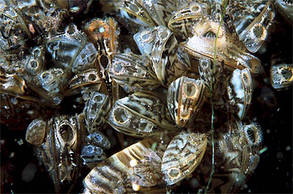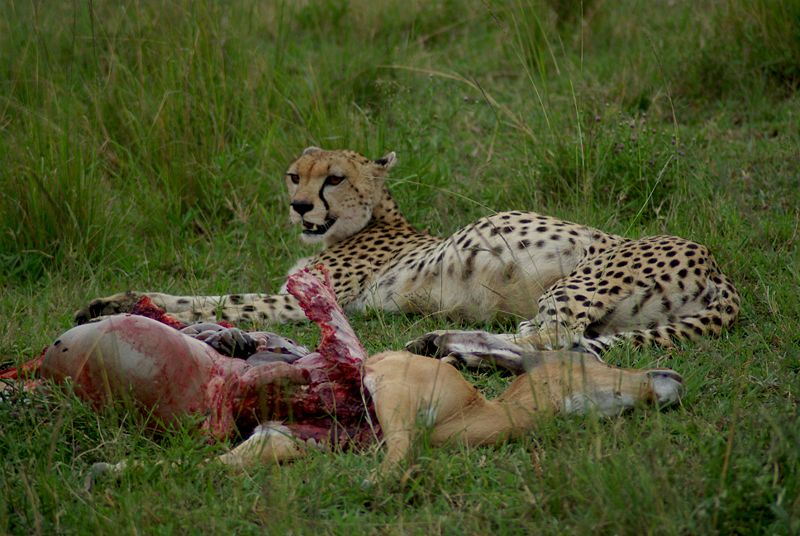Ben - This is the very last Naked Scientists show of 2009. So we thought we'd look back on a few of your favourite bits. It's been a great year. We've had some very interesting guests, been to some incredible places, and done some fantastic experiments. But first, Helen, what's been some of your favourite bits?
Helen - Oh, well there's so much to choose from. But I think something that stood out for me was when we had Dr. David Aldridge in the studio from Cambridge University. And he brought with him some creatures found in freshwaters around the world that really shouldn't be where we find them. So this was all about the science of invasive species. And he brought some critters for us to look at.
Ben - And we can have a listen to that now...
David - I've got a little menagerie of goodies here. And I've got some zebra mussels.  I've got a signal crayfish from North America. And I've got a Chinese mitten crab. They're beautiful. But unlike our native freshwater mussels which just sit in the bottom of rivers with their foot being into the mud, zebra mussels have a beard, a bit of thread which is like the marine mussels that you eat. So zebra mussels are able to sit on solid surfaces. And they can attach to each other and sit in dense layers. So they can foul pipelines and drinking water supplies, cooling systems to power plants, irrigation systems. But also they sit on our native wildlife and one of the things they really threaten, such as a specimen I've got in front of me, are our native mussels which provide a really good substrate and they choke them and cause them to die.
I've got a signal crayfish from North America. And I've got a Chinese mitten crab. They're beautiful. But unlike our native freshwater mussels which just sit in the bottom of rivers with their foot being into the mud, zebra mussels have a beard, a bit of thread which is like the marine mussels that you eat. So zebra mussels are able to sit on solid surfaces. And they can attach to each other and sit in dense layers. So they can foul pipelines and drinking water supplies, cooling systems to power plants, irrigation systems. But also they sit on our native wildlife and one of the things they really threaten, such as a specimen I've got in front of me, are our native mussels which provide a really good substrate and they choke them and cause them to die.
Helen - That's a huge mussel you've got there. And I can hardly see it. It's been covered in smaller zebra mussels. That's incredible. And the Cray fish you got there, that looks quite tasty. Can we eat those?
David - We can. And that's the reason they were brought over here. The American signal crayfish was brought over in the 1970s as a commercial aquaculture food. The problem with these crayfish is that they can walk over land so they escaped out of these little ponds they were put in. And they can move into the wider environment, so they are very good at changing the ecosystem through feeding on the bottom rooting plants, the macrophytes. And they dig burrows, which can cause sort of destabilisation of the banks. But perhaps of greatest of immediate concern is that they carry a fungus, something called crayfish plague, which kills our native crayfish species, but these American ones are pretty resistant to it. So we've had, for instance, in the Cam in 2000, an outbreak of plague which wiped out native crayfish from about 20 kilometres of river.
Helen - That was Dr. David Aldridge telling us about some of the creatures that get into freshwater bodies and cause trouble where they shouldn't be. And we had a look at some of them in the studio. And that was quite fun. That was great.
Ben - It's very nice to have our own innovation of invasive species. It's not often people bring things into the studio.
Helen - I think we should do that more often. And that's what we should do in 2010, is bring creatures into the radio studio. Is that alright with everyone else?
Ben - Well we do have a cooked chicken with us . But I think that's a slightly different way of thinking about these. Now, speaking of species that we don't want around, there was also a lovely new story from earlier in the year about the love song of the mosquito. Now if you listen very carefully to this, you could almost hear Dr Kat squirming in her seat.
 Chris - Now have a listen to this... That is a male mosquito buzzing its wings at something like 600 hertz, 600 times a second.
Chris - Now have a listen to this... That is a male mosquito buzzing its wings at something like 600 hertz, 600 times a second.
Now have a listen to the female mosquito; these are Aedes aegypti mosquitoes. Here we go...
Now I won't subject you to too much more because Dr Kat has got her fingers in her ears but that's at about 400 hertz.
But if you do what two researchers at Cornell did, that's Lauren Cater and Ben Arthur, they put one of those mosquitoes tethered to a pin with a piece of superglue to keep it in one place. Then they bring in a mosquito of the opposite sex and record what happens to the wings of the two. Have a listen to this...
And what's actually happening is that the two mosquitoes are adapting the beating frequency of their wings so that they harmonise.
Ben - Isn't that lovely, mosquitoes singing in harmony? And I've never seen such a visceral reaction as Kat squirming in her seat like that. But fair enough it's a horrible sound, the sound of mosquitoes. But I thinking of something a bit more pleasant. We've had loads of great experiments in Kitchen Science.
I remember at the start of the year, we made some jelly to show how fruit enzymes can cut up proteins and stop the jelly from setting. Although I think it may have just been an excuse to make lots and lots of jelly. But, Dave, what else have you really enjoyed this year?
Dave - There are all sorts of things this year. Ranging from videoing popcorn popping, watching they way... It's absolutely beautiful the way it unravels because it's a really strong pressure vessel, you get it really hot and the water inside boils. The pressure builds up and it breaks. And it opens itself up almost all the way. So I got a few minor oil burns from that one - it's not something you really want to try at home.
We did all sorts of lovely things which I keep bringing out at dinner parties as well. There's one which I found from a guy I met at the British Interactive Group. You just have a nut on one end of a piece of string and a mug on the other end, hold it over a pencil and just let go of the nut. Despite what you'd expect, every time as long as you don't mess-up too badly, the nut runs wraps itself around the pencil and it doesn't hit the ground.
I also had one which actually got a proposal of marriage from my housemate which my girlfriend wasn't entirely impressed with, which was getting an orange peel, an especially good juicy orange peel and squeezing it next to a candle. You get these huge fireballs, maybe five or six inches across. It's absolutely beautiful especially in slow motion as well.
Helen - That's very cool. I like that one too, actually. But another one that sticks on my mind especially was when you soaked me in the studio. I thought that was rather mean. But it was great fun. And I think we've got a clip from that one coming up...
Dave - So if you spin that nice and quickly...
Helen - Do I let go of it or do I try to hold on to it?
Dave - Just keep holding it and spinning it nice and quickly.
Helen - In one direction?
Dave - In one direction.
Helen - Oh! Oh I see. I see.
chris - That was fantastic.
Helen - I'm covered in water. And that's the last time I offer. So what happened is the waters flew out of the open ends of the straw. I'd have another go but I think I might get the microphone wet.
Dave - Yeah, we should be careful.
Chris - That was really good.
Helen - It was awfully but rather a beautiful fountain for a moment there.
Ben - Well, clearly that tickled Dr Chris. Dave, did you know that was going to happen?
Dave - I'm afraid that fairly simple physics made it pretty inevitable that that was going to happen.
Helen - Ooh, I'm shaking my fist. Oh well, anything in the name of The Naked Scientists, that's fine.
Ben - Of course. And we didn't get any microphones wet, not at all. We do never do anything that could in any way harm any of the equipment in the studio. We wouldn't dream of it.
Now I've really enjoyed meeting some of the people I've interviewed this year. I spoke to science minister Lord Drayson about why science is so important. But a bit more fun was talking to comedian Robin Ince about how science and comedy are very closely linked.
Robin - What is happening is there's a huge, an accidental rational movement basically. I think after we put together the show Nine lessons and carols for Godless people where we, on the science side, you had Simon Singh, Ben Goldacre, Richard Dawkins, then various musicians people like Jarvis Cocker and Darren Hayman, and then comedians. And all of them are doing something on the rational world. And you have people like Dara O'Brien, Chris Addison, Stewart Lee and Josie Long, all of them are approaching things from a rational spectrum. Especially Dara who has a physics background. He's very excited about talking about science. And I think that perhaps, I don't know, but perhaps TV isn't really pandering very much to intellectual programming. So I think there has been an accidental rational/scientific movement start in comedy.
Dave - And we've also been to some amazing places this year. Laura Soul climbed to Everest base camp and reported back on how her body reacted to the low levels of oxygen. It clearly wore her out somewhat... 
Laura - Yes. It's good to sit down. I have a bad headache and so do most people. I felt a bit sick on the way but I'm OK now. Some people feel very sick. The view from here is absolutely amazing. You can see the Khumbu ice fall which is really beautiful with these huge big jagged peaks of ice. It's been a very hard route to get up here. But I'd say that it was definitely worth the climb.
Helen - I think you can just about feel kind of just how exhausted she is. It's amazing. Well, I was rather, well I was a little bit envious, I have to say, of Meera's trip to South Africa this year and when she got to meet some cheetahs. How lovely...
John O'Brian - Somewhere very nearby here is a cheetah on a kudu kill...there we go...
Meera - Oh my God! Yeah. Uh-oh. It spotted us. Does that matter?
John O'Brian - Oh, no, no, no. They're very relaxed. They're feeding so it's got other things on its mind. And cheetahs aren't, animals that are dangerous or anything to humans.
 Meera - So we've parked up alongside this tree. And I can just see the cheetah's body and its head, and oh, its tails wagging now. It is just quite literally having a feast down there, munching away.
Meera - So we've parked up alongside this tree. And I can just see the cheetah's body and its head, and oh, its tails wagging now. It is just quite literally having a feast down there, munching away.
Ben - You can hear how excited she is by that little gasp of breath. Really excited to hear that. It's also quite nice to know that cheetahs are quite a bit like my cats at home and that once you gave them some food, they don't care about anything else whatsoever.
- Previous Why Skull Bone is Special Bone
- Next Acoustic Archaeology









Comments
Add a comment